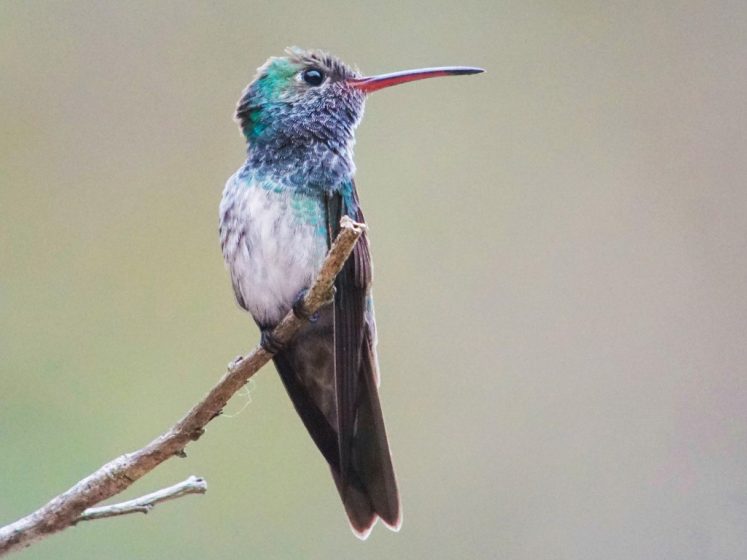The Honduran Emerald (Amazilia luciae) is a little-known hummingbird in Trochilidae. The bird is endemic to the dry forest of Honduras. The bird’s natural habitats are subtropical or tropical dry forests and subtropical or tropical dry shrubland. Monroe, the Birds of Honduras, summarized what was then known about the species; nothing has been added since. So far, eleven specimens have been collected at various localities, from Santa Barbara in the west to Catacamas.
It is speculated that A. luciae was a forest inhabitant and may be common locally. Destruction of forests and loss of habitat pose a threat to the Honduran Emerald. The hummingbird restricted its distribution in dry forest fragments and increased human pressure on this habitat. George Lawrence first described the species in 1867.
In 1983, the AOU Checklist of North American Birds listed the habitat of A. luciae as unidentified, with localities usually in the humid lowlands. Though plotting the collecting localities on a habitat map of Honduras reveals that all sites where A. luciae has been taken lie in or close to arid and mixed scrub and thorn forests, It is a common inhabitant of arid thorn forests and scrubs in the upper Rio Aguan Valley Department of Yoro.
Like other hummingbirds, it is a medium-sized hummingbird. It has a straight bill that is only slightly decurved. Normally, the bill is blackish above and red below with a dark tip. The plumage pattern is simple: green upper parts that become more bronze toward the tale; a blue throat; a gray belly; and a forked tail that is bronzy green. Females are like males but overall duller in coloration.
Approximately six kilometers west-northwest of Coyoles, there were at least six emeralds found in one hour. A few flowers were evident, and all emeralds appeared in response to imitations of Ferruginous Pygmy-Owl calls. The Honduran Emerald seemed slow to respond and frequently appeared well after a mobbing band of other birds. This is mainly White-bellied Wrens and White-lored Gnatcatchers that have formed. Emeralds normally perched 1.5 to 8 m up in bare trees and bushes and sat for up to 30 sets before losing interest.
There was a pygmy owl that did appear, and one emerald stayed with it for more than a few minutes. Moreover, the other bird species at the site included Cinnamon Hummingbird, Black-headed Trogon, Elegant Trogon, Northern Beardless Tyrannulet, Brown-crested Flycatcher, and Green Jay. At that site, emeralds were seen on the morning of June 8, 1988. At least 12 to 15 individuals were present in a small area 200 x 200 m. However, at the second site, emeralds fed numerous flowering plants.
Numerous birds also made prolonged insect-catching flights, mainly around the trunks of organ pipe cacti. One bird strongly defended the territory of about 10 x 10 m against the two other emeralds, which infrequently came by to feed on Pithecelobium. Also, other birds’ characteristics of the Olanchito site included those listed for Coyoles, plus Thicket Tinamou, Spot-bellied Bobwhite, Striped Cuckoo, Lesser Ground-Cuckoo, Fork-tailed Emerald, and Arremonops sp., referred to as Green-backed Sparrow by Monroe in 1968.
At both sites, we found arid conditions, like the upper Aguan valley. Therefore, most thorn forests had been cleared for grazing and what little remained was very dry, with few birds of any species apparent. From close-range observations of at least 15 emeralds, A. luciae is slightly smaller than A. rutila and its posture and habits vary little from those of other Middle American amazilia. Nevertheless, the sexes appear to differ only slightly, mainly in the intensity and extent of the gorget. The Honduran Emerald is considered solitary, like most hummingbirds. Individuals congregate in areas with a high density of nectar resources.
In life, the maxilla is blackish, and the mandible is pinkish-red with a dark tip. The bill appears relatively long and slightly decurved. A white post-ocular spot and a smaller pre-ocular spot lend the species a characteristic facial expression. The upper parts are deep emerald green and the upper tail coverts, and tail are bronzer with a blackish subterminal band on the outer rectrices.
Remiges are dark brown. Seen in the right light, the gorge flashes solidly turquoise but most of the time the underparts appear pale grayish, with dark mottling on the throat and upper chest. At rest, the wings fall slightly short of the distinctly cleft tail. Feet are dark gray. One bird (apparently singing) appeared in very fresh plumage.
A second, relatively dull female bird had the outer two primaries and several secondary’s very worn and faded in contrast to the newer and darker remiges; no rectrix molt was noted on any birds. The most commonly heard vocalizations were a hard, slightly metallic ticking call, often steadily repeated, “chik, chik-chik, chik, chik. Also, a slightly buzzy chatter is given in flights ‘zzchi’ and ‘chik chi zzhi’ reminiscent of the calls of Chestnut-collared Swift.
On returning to a perch, an emerald defending its feeding territory often uttered a dry, quiet gruff warbling, possibly the song, or at least a whisper song. During intra-specific chasing, we heard a hard-buzzy chatter ‘chirr-rr-rr-rr-rr-rr-rr’ and a high sharp’siik’ given in pursuit. Moreover, an association with arid interior valleys explains the restricted range of A. luciae.
Hence, given the pressure to convert much land to agricultural practices, A. luciae may be a threatened species. The actual distribution of the Honduran Emerald is still partially known. Within dry forests, the bird species has only ever been seen in interior valleys on the Caribbean Slope. An estimated population of 250 to 999 individuals is speculative, but the source is unknown.
Read More: The Rufous Treepie (Dendrocitta vagabunda)













